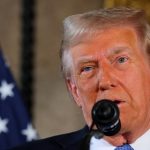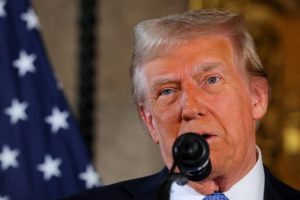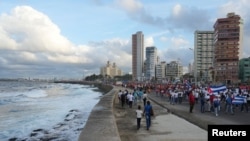Peruvian President Dina Boluarte attended the appointment with the Prosecutor’s Office to respond to the accusations against her of “genocide, qualified homicide and serious injuries” during the social outbreak in the country, which began last December and lasted throughout the month from January. The anti-government demonstrations left 49 dead, according to human rights organizations.
Guarded by a police cordon. This is how the president of Peru, Dina Boluarte, arrived this June 6 at the headquarters of the National Prosecutor’s Office after being summoned to testify about the deaths during the past anti-government protests, which began in December 2022 and lasted until the end of January. A social outbreak that left at least 49 dead, according to the Peruvian Ombudsman and international human rights organizations.
With no more statements than a message on the Twitter account of the Presidency of the Republic: “Boluarte arrived at the Peruvian Prosecutor’s Office to provide statements regarding the investigations being followed by the Public Ministry”, the president now comes to answer for the serious accusations against him.
Shortly before, her lawyer, Joseph Campos, assured the local media that the president will not accept “the right to silence during this procedure for the deaths of adults and minors during the violent repression of protests against her government.”
Boluarte herself, whom both protesters and the relatives of the victims accuse of being responsible for the “massacres” that occurred in the south of the country during the weeks of social and political instability, said last week that her intention is to “clarify the facts as quickly as possible” and that he was not going to use the prerogative of having his statement taken at the Government Palace.
Upon leaving, after almost three hours testifying before the nation’s prosecutor, Patricia BenavidesThe president did not make statements to the media.
Moments ago, the President of the Republic, Dina Boluarte, arrived at the @fiscaliaperu to provide statements regarding the investigations being followed by the Public Ministry.
– Presidency of Peru ?? (@presidenciaperu) June 6, 2023
The politician, who rose to office after the abrupt departure of former President Pedro Castillo on December 7, after he tried to close Parliament and govern by decree, assured that he will only provide a statement before the attorney general: “It is the only competent authority in investigations of senior officials of the Peruvian State in accordance with the law”.
For his part, the President of the Council of Ministers, Alberto Otárola, defended the Peruvian Executive, diverting responsibility to the Armed Forces and the Police. In Spain, where he is on an official trip, he was greeted by Peruvian demonstrators with shouts and banners of “Otárola murderer.”
From Madrid, he told EFE that those uniformed officers who “misused their weapons” should be investigated, but he defended that their actions “did not respond to an order from the Executive.”
The Prosecutor’s Office opened the case in January for “the deaths of citizens during social mobilizations between December 2022 and January 2023.” Boluarte is accused of the alleged crimes of “genocide, qualified homicide and serious injuries” against her and her Executive, for violent acts in southern regions such as Puno, Junín or Ayacucho, with an indigenous majority.

Already last March, Boluarte was questioned for the first time, but she cannot be tried until the end of her mandate, as ordered by the Peruvian Constitution. Otárola, her predecessor Pedro Angulo and the former Minister of the Interior: Víctor Rojas and César Cercantes, as well as the Defense Minister, Jorge Chávez, are also called to testify. Even the head of the Joint Command of the Armed Forces, Manuel Gómez de la Torre, was summoned on Monday, but he did not appear.
Several people arrived this Tuesday at the headquarters of the Prosecutor’s Office, in the historic center of the capital, Lima, with banners that read: “No more dead” or “Dina and Otárola murderers of the people”, as a sign of protest.
Peruvians in Spain arrived at the airport in Madrid to show their indignation at Prime Minister Otárola for the massacres in protests. pic.twitter.com/1452ZMh7gx
— ?? Wayka (@WaykaPeru) June 5, 2023
What happened during the social outbreak in Peru?
In a little less than three months, almost fifty people died as a result of the clashes during the demonstrations that took place throughout the country, but which had a greater echo and were appeased with a brutal repression in the south. For several weeks, the protesters took to the streets in support of former president Castillo –arrested at the beginning of December–, demanding, among other things, the closure of Congress and the advancement of the elections.
A month ago, the Inter-American Commission on Human Rights presented a report confirming that there were “violations of human rights by state agents during the protests.” The OAS body asked the Peruvian Justice to “investigate, prosecute and punish” those responsible and described the events as a “massacre”.
The IACHR’s independent investigations indicate that the victims received “impacts from firearms, including pellets, to the upper part of the body.” In an interview with the Peruvian media ‘public eye‘, the highest representative of Amnesty International, Agnès Callamard, exposed an alleged racist bias in the repression of Peruvian law enforcement.

“Our report found that the use of lethal force by Peruvian security agents was done exclusively in regions outside of Lima. In addition, the main objective has been people of indigenous and peasant roots. This suggests a well-marked racist bias in the use of lethal force,” Callamard told ‘Ojo Público’.
On May 25, the human rights organization issued a new report documenting the violence against civilians in the outbreak under the title “Lethal racism: extrajudicial executions and illegitimate use of force by security forces in Peru”. The document analyzes 52 cases of people killed or injured, with an emphasis on the southern regions. Of the 25 deaths in the south, they attribute at least 20 to state forces who, according to what they say, would have fired live ammunition against vulnerable areas of the body such as the head, neck, thorax or abdomen that “may constitute extrajudicial executions committed by state forces”. .
“Far from being isolated incidents attributed to uncontrolled agents acting on their own, the number of deaths on multiple dates and in different places suggests a deliberate and coordinated state response,” says the text, which also urges the Peruvian authorities to investigate “the possibility that higher-ups would order or at least condone these killings, no matter how high up the chain of command they go.”
With EFE, AFP and local media






![[Img #74676]](https://thelatestnews.world/wp-content/uploads/2024/12/Laser-artificial-neuron-150x150.jpg)







